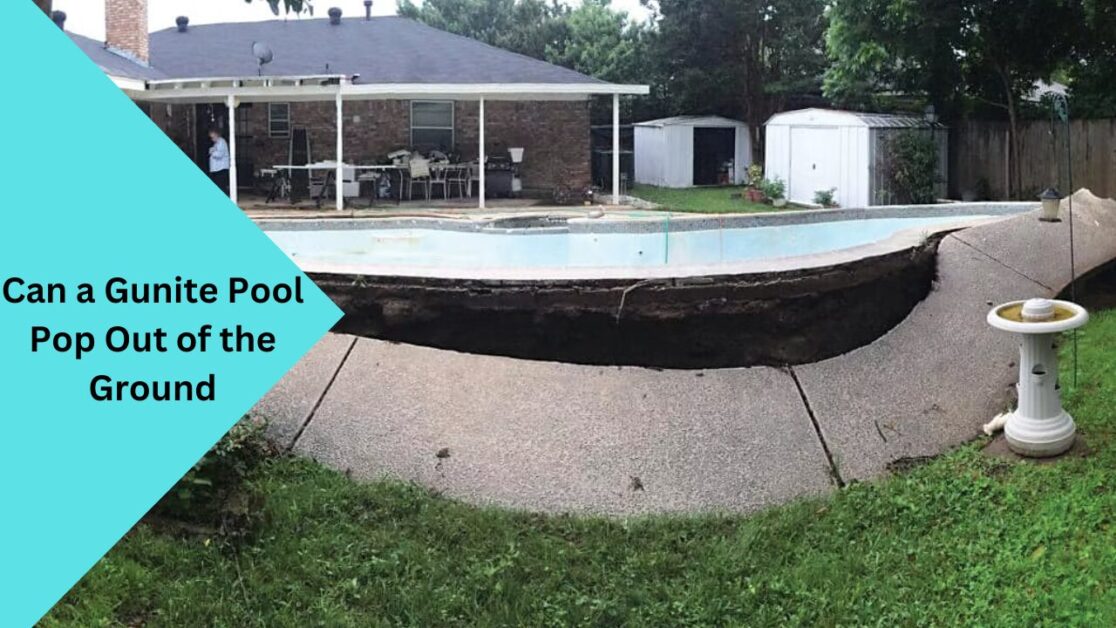Imagine having a beautiful gunite pool in your backyard, where you and your loved ones can relax and cool off during hot summer days. However, a lingering question arises. Can a gunite pool pop out of the ground? In this blog post, we will explore the possibility of such an event and discuss the causes, signs, and preventive measures associated with pool pop-outs. Let’s dive in!
- Can a Gunite Pool Pop Out of the Ground?
- How Does a Pool Pop Out of the Ground?
- What causes a Pool to Pop Out?
- Understanding Gunite Pool Construction
- Factors That Contribute to Pool Pop-Outs
- Signs and Risks Associated with Pool Pop-Outs
- Potential Damage to the Pool and Surrounding Areas
- Corrective Measures and Repairs
- Preventive Measures to Avoid Pool Pop-Outs
- Conclusion
Can a Gunite Pool Pop Out of the Ground?
Gunite pools are renowned for their durability and structural integrity. However, like any structure, there is always a possibility of unexpected events occurring. Understanding the factors that may cause a gunite pool to pop out of the ground is crucial in ensuring the longevity and safety of your pool.
How Does a Pool Pop Out of the Ground?
Pool pop-outs can result from a combination of various factors, such as hydrostatic pressure, inadequate drainage, extreme weather conditions, and poor soil conditions. The intricate relationship between these elements can lead to the gradual or sudden displacement of a pool.
What causes a Pool to Pop Out?
- Soil Conditions and Hydrostatic Pressure:
- Erosion of soil beneath the pool due to inadequate compaction or water seepage.
- High water table levels, especially during heavy rainfall or flooding, exerting hydrostatic pressure on the pool walls and floor.
- Inadequate Drainage and Pool Maintenance:
- Improper installation or malfunctioning of drainage systems, which can lead to water accumulation around the pool.
- Negligence in maintaining the pool’s water balance and chemical treatment, resulting in excessive pressure within the pool structure.
- Natural Disasters and Extreme Weather Conditions:
- Earthquakes, which can cause ground movements that result in pool displacement.
- Severe frost or freeze-thaw cycles leading to the expansion and contraction of the soil, destabilizing the pool.
Understanding Gunite Pool Construction
To fully grasp the possibility of a pool pop-out, it is essential to comprehend the construction process of a gunite pool.
The Process of Building a Gunite Pool
Building a gunite pool involves several key steps:
- Excavation: Digging a hole to the desired pool shape and dimensions.
- Structure Framing: Constructing a steel framework, known as rebar, to provide structural reinforcement.
- Plumbing and Electrical: Installing the necessary plumbing and electrical components for the pool’s filtration and circulation system.
- Gunite Application: Spraying a mixture of sand, cement, and water, known as gunite, onto the rebar framework to create the pool shell.
- Finishing Touches: Applying a finish such as plaster, tile, or aggregate to complete the pool’s interior.
For full details about gunite pool construction, just click our latest article about How to Build a Gunite Pool: Step-by-Step Guide
Factors That Contribute to Pool Pop-Outs
While gunite pools are designed to withstand various forces, several factors can contribute to the possibility of a pool pop-out. Let’s explore these factors in detail.
Soil Conditions and Hydrostatic Pressure
The soil surrounding a pool plays a vital role in its stability. Factors such as soil type, compaction, and water table levels impact the risk of a pool pop-out.
In regions with clay or expansive soils, poor compaction during the excavation process can leave gaps that allow water to accumulate beneath the pool. The hydrostatic pressure from this trapped water can gradually push the pool out of the ground.
Inadequate Drainage and Pool Maintenance
Proper drainage is crucial to prevent water accumulation around the pool. Inadequate or malfunctioning drainage systems can result in hydrostatic pressure build-up and increase the risk of a pool pop-out.
Regular maintenance of the pool’s water balance and chemical treatment is also essential. Water imbalances can lead to the deterioration of the pool’s structure, weakened walls, and potential displacement.
Natural Disasters and Extreme Weather Conditions

Natural disasters and extreme weather events can pose significant risks to pool stability. Earthquakes can cause ground movements, leading to structural shifts that result in pool pop-outs.
Additionally, severe frost or freeze-thaw cycles can cause the soil to expand and contract, destabilizing the pool over time. It is crucial to consider the region’s climate and potential weather events when assessing the risk of a pool pop-out.
Signs and Risks Associated with Pool Pop-Outs
Recognizing the early warning signs of a pool pop-out is crucial for timely and effective intervention.
Identifying Early Warning Signs
- Uneven Pool Deck: The pool deck may appear uneven, showing signs of an uneven pool structure below.
- Cracked or Shifting Tiles: The tiles surrounding the pool may crack or shift due to ground movement, indicating a potential pop-out.
- Bulging Walls: The walls of the pool may start bulging outward, a clear indication of hydrostatic pressure build-up.
- Separation of Coping or Decking: Separation between the pool coping, which covers the pool’s edge, and the deck may occur due to a pool pop-out.
Potential Damage to the Pool and Surrounding Areas
When a pool pops out of the ground, significant damage can occur. Apart from the structural implications, neighboring structures, such as fences or landscaping, may also be affected. The risks associated with a pool pop-out extend beyond the pool itself, making prompt action necessary.
Can a Gunite Pool Be Left Empty?
Leaving a gunite pool empty for an extended period can increase the risk of a pool pop-out. Without adequate water to counterbalance the hydrostatic pressure, the pool shell may experience outward displacement.
To explore more details and considerations regarding Gunite Pool Empty, our comprehensive guide on Can a Gunite Pool Be Left Empty? Exploring Problems, Solutions, and Conversions has you covered.
If you need to keep your pool empty for an extended period, consult a professional contractor to ensure the pool remains structurally sound and appropriate measures are taken to minimize the risk of a pop-out.
Fixing an Inground Pool That Popped Up
If your pool has experienced a pop-out event, it is crucial to address the issue promptly and effectively. Consulting a professional pool contractor with experience in pool repairs is highly recommended.
Corrective Measures and Repairs
- Professional Assessment: A qualified pool contractor will assess the extent of the damage and identify the underlying causes of the pop-out.
- Drainage Management: Implementing proper drainage systems can help alleviate hydrostatic pressure and prevent future pop-outs.
- Structural Repairs: Depending on the severity of the pop-out, structural repairs may involve re-leveling the pool and reinforcing the walls using techniques such as helical piers or underpinning.
- Resurfacing and Finishing: After necessary repairs, the pool may require resurfacing to restore its aesthetic appeal.
Preventive Measures to Avoid Pool Pop-Outs
Prevention is always better than cure. By implementing preventive measures, you can minimize the risks associated with pool pop-outs. Consider the following steps:
Proper Pool Construction and Design
- Professional Pool Contractor: Engage the services of a reputable and experienced pool contractor with expertise in gunite pool construction.
- Thorough Excavation and Compaction: Ensure proper soil compaction during the excavation process and address any potential soil-related issues before construction.
- Pool Rebar Placement: Reinforce the pool’s structure with adequate rebar placement and spacings.
- Engineering Considerations: Follow local building codes and consult with engineers to account for soil conditions and hydrostatic pressure.
Regular Maintenance and Inspections
- Adequate Drainage Systems: Install and maintain drainage systems to manage water accumulation around the pool effectively.
- Water Balance and Chemical Treatment: Regularly test and maintain the pool’s water balance and chemical levels to prevent deterioration of the pool structure.
- Professional Inspections: Schedule regular inspections by a qualified pool professional to identify potential issues early on and ensure proper upkeep of the pool.
Handling Potential Risks Proactively
- Monitor Water Table Levels: Keep track of local water table levels during periods of heavy rainfall or flooding and take appropriate measures to alleviate any excessive water pressure.
- Weatherproofing: Consider weatherproofing measures such as frost protection during freezing temperatures.
- Landscaping Considerations: Properly plan and design landscaping around the pool to avoid potential water drainage issues.
Conclusion
In conclusion, while the possibility of a gunite pool popping out of the ground exists, it is essential to understand the contributing factors and take proactive measures to mitigate such risks. Regular maintenance, proper construction, and professional inspections play a crucial role in ensuring the longevity and safety of your gunite pool. By following the preventive measures outlined in this guide, you can enjoy your pool oasis with peace of mind, knowing that your pool is resistant to pop-outs. So, dive in and make lasting memories in your gunite pool while taking proactive steps to protect it for years to come!

Greetings, fellow pool enthusiasts! I’m Turner Davis, your dedicated guide to the world of pool care and maintenance. With over a decade of experience in the field, I’ve made it my mission to transform ordinary pools into extraordinary aquatic retreats.

